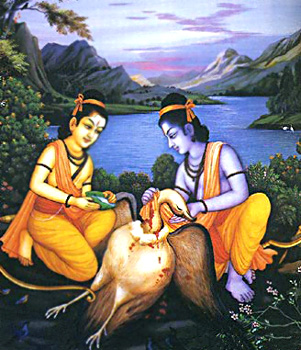 Grief of Rama was roused when he found the hermitage in the Panchavati forest empty. He, however, blamed Lakshmana for leaving Sita alone and going after him in the forest. After discovering that Sita was not in the hermitage, both Rama and Lakshmana searched every nook and corner of the forest and the mountain ranges. Rama, after killing the asura Maricha who was in the guise of a golden deer, returned to his hermitage at Panchavati forest and met Lakshmana in the way. He blamed his younger brother for leaving Sita. The jackals howled and birds cried as the two brothers hurried back. As they came closer to the hermitage the feet of Rama failed him, and a trembling shook his frame for Sita was not there in the hermitage. They searched the groves of flowering trees, and the river banks where lotus-flowers were open, and sought the mountain caves, and asked the river and the trees and all the animals where Sita was. Then Rama thought that rakshasas had eaten her, and took the revenge for Khara`s death.
Grief of Rama was roused when he found the hermitage in the Panchavati forest empty. He, however, blamed Lakshmana for leaving Sita alone and going after him in the forest. After discovering that Sita was not in the hermitage, both Rama and Lakshmana searched every nook and corner of the forest and the mountain ranges. Rama, after killing the asura Maricha who was in the guise of a golden deer, returned to his hermitage at Panchavati forest and met Lakshmana in the way. He blamed his younger brother for leaving Sita. The jackals howled and birds cried as the two brothers hurried back. As they came closer to the hermitage the feet of Rama failed him, and a trembling shook his frame for Sita was not there in the hermitage. They searched the groves of flowering trees, and the river banks where lotus-flowers were open, and sought the mountain caves, and asked the river and the trees and all the animals where Sita was. Then Rama thought that rakshasas had eaten her, and took the revenge for Khara`s death.
Rama and Lakshmana meet the wounded Jatayu
While searching for Sita in the jungle, they came to where Jatayu had fought with Ravana, and saw the broken weapons and the car and the trampled ground; and Rama raged against all beings, and was on his way to destroy the very heavens and earth, unless the gods gave back his Sita. Then they found the dying Jatayu, and thinking him to be a rakshasa that had eaten Sita, Rama was about to slay him when Jatayu spoke feebly, and related to Rama all that had befallen. After hearing everything, Rama threw his bow and embraced the friendly bird and lamented for his death. Jatayu told of Ravana and assured Rama of a certain victory over the demon and the rescue of Sita. After that, his spirit fled away, and his head and body sank down upon the ground; and Rama mourned over his friend. He ordered Lakshmana to prepare for the funeral of the great soul and Lakshmana brought wood and fire, and they burned Jatayu there with every right and offering due to twice-born men, and spoke the mantras for his speedy coming to the abodes of the shining gods.
After completing the funeral rites of Jatayu, Lord Rama and Lakshmana set out to search for Sita far and wide and they met a horrid rakshasa, and it was no light matter for them to come to their above in battle with him. The rakshasa was wounded to death, but he rejoiced, for he had been cursed with that form by a hermit until Rama should slay and set him free. Rama and Lakshmana burnt him on a mighty pyre, and he rose from it and, mounting upon a heavenly car he told to Rama to seek the help of the great monkey Sugriva and the four other monkeys that dwelt on the mountain Rishyamuka. He told that Sugriva is a royal monkey, who is also very puissant, humble, brave, expert, and graceful; good at shifting shapes, and well acquainted with the haunts of every rakshasa. He told Rama and Lakshmana to go towards the Rishyamuka Mountain where they would find the great monkey and told them to form an alliance with them and fight with the demons to rescue Sita. With this ends the Aranya Kanda of Ramayana.



















